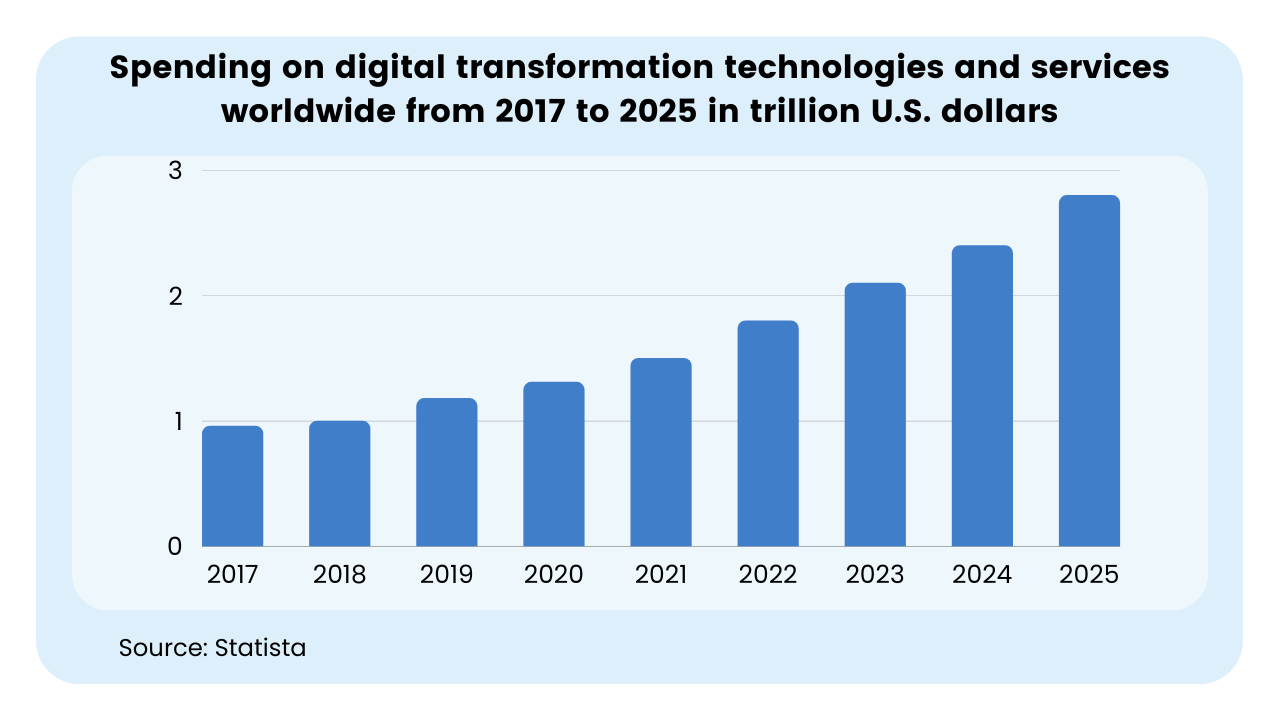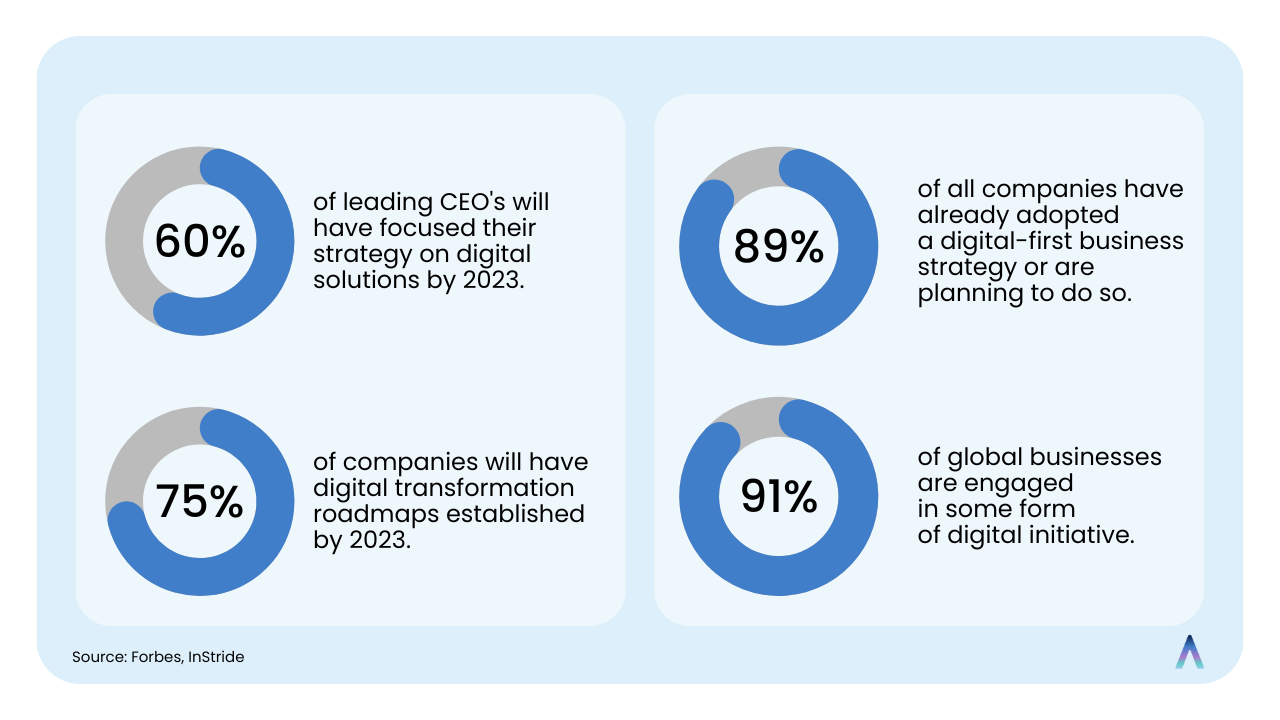
Future of Digital Transformation and Trends in 2024: Expert View
Digital transformation is no longer a corporate tactic used to reform an organization’s operations – that’s what the Bloomerg experts concluded. It now has become a necessary undertaking sought out by CIOs and CTOs worldwide.
Various statistics underscore the significance of this trend. Global spending on digital transformation technologies is expected to hit 2.8 trillion dollars by 2025. This represents a 40% projected growth over the next three years.
How does this shift in the adoption of modern technology influence the business landscape? In this article, we are aiming to answer this very question.
Contents
- What is digital transformation?
- Why is digital transformation important?
- Future of digital transformation – statistics and forecasts
- What’s the future of digital transformation? 7 important trends in 2024
- 1. High-performance software
- 2. No-code/low-code
- 3. Artificial Intelligence (AI) and Machine Learning (ML)
- 4. Multi-cloud solutions
- 5. Cybersecurity
- 6. Blockchain development
- 7. Software 2.0
- How to lead a successful transformation project
- An expert’s point of view
What is digital transformation?
Let’s start with the basics.
What really is a digital transformation?
It is a tricky question because, by itself, digital transformation is pretty much meaningless. It is rather an umbrella term that encompasses the sum of the company’s efforts and investments in innovative technologies which aim to improve its day-to-day operations.
One thing is for sure – it’s not a buzzword, much like Industry 4.0, or agile. In reality, it is a much larger, more complex concept.
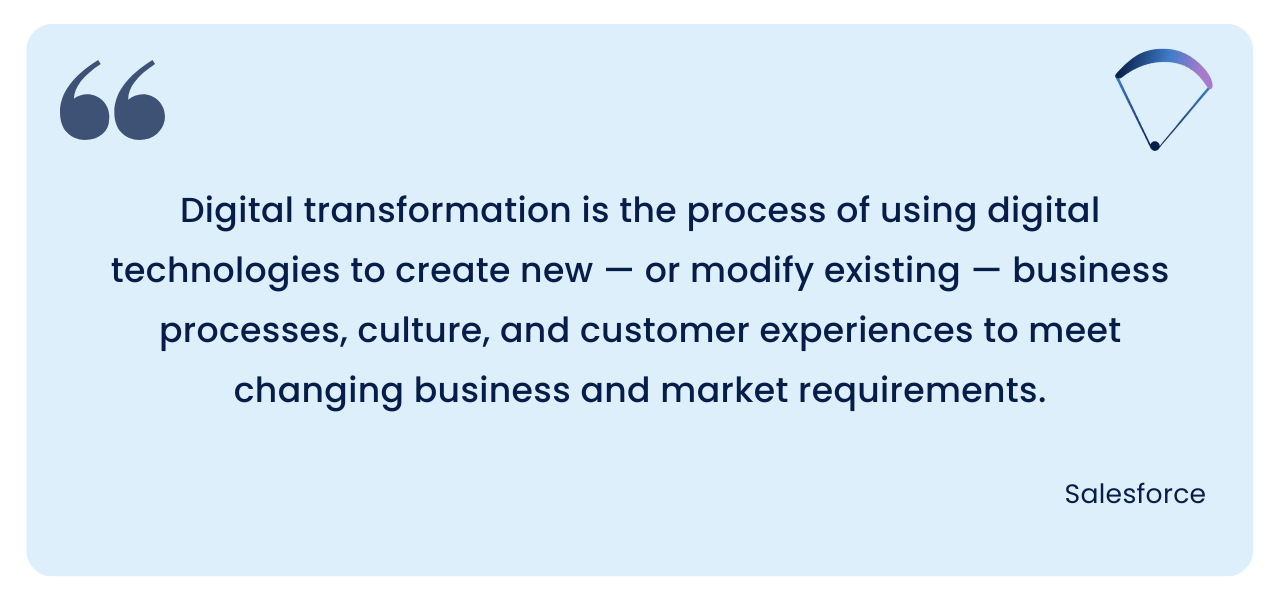
Recent technological advancements allow companies to rapidly collect, analyze and transmit data, and play a key role in ensuring a digital transformation success. Solutions like artificial intelligence, mobile technologies, and cloud computing are invaluable assets for digital savvy leaders that seek to improve their digital transformation strategy and make it compatible with ever-changing customer expectations.
In the past two decades, companies that were able to leverage these technologies in commercial applications were able to quickly dominate the entire market.
What’s more, current digital leaders like Amazon, Uber, Booking, or Airbnb have even been able to completely change how ordinary people perceive certain products and services.
Why is digital transformation important?
If you don’t adapt, you don’t endure – this old saying is now more important than ever.
To remain competitive in a rapidly changing business landscape, organizations must quickly adapt their strategies and embrace the digital change. In reality, it means closely following the latest digital technology trends and working on ways of incorporating them into business operations. Check also the latest software development trends.
We’ve all heard precautionary tales of companies like Blockbuster and Kodak. They warn us about what happens to companies that stick to their old ways and fall behind the market trends.
We should also address the elephant in the room – the COVID-19 pandemic.
During the global pandemic, the world was forced to adopt digital tools, at an accelerated pace, just to keep their businesses afloat. Even though a lot of these emerging technologies were available to organizations even before the pandemic, the strict health guidelines left no choice but to adapt them in reality.
Now, the post-pandemic world has proven that a lot of these digital initiatives work and improve business performance regardless of the covid-related restrictions.
[Read also: Digital Transformation in the Travel and Tourism Industry]
Future of digital transformation – statistics and forecasts for 2024
Modern companies from various industries, such like: ecommerce, travel, real estate, fintech, insurance have been embracing digital transformation for a while now, with many integrating digital technologies in their digital transformation strategies. Now, smaller enterprises and startups can also increase the digital transformation market size and business value with the use of business innovation platforms and low-code solutions. Read here about the role of low-code in digital transformation.
Market research statistics clearly show how digital transformation has become a global trend, enhancing organizational culture with a spirit of continuous improvement.
According to the latest data, in 2021 alone, 1.5 trillion USD was spent on digital transformation globally.
And the investments show no sign of slowing down!
Digital innovation spending is projected to have a CAGR of 19.1% over the next four years, with cumulative global spending reaching a staggering 6.8 trillion USD just next year.
[Read also: Future of Business Intelligence]
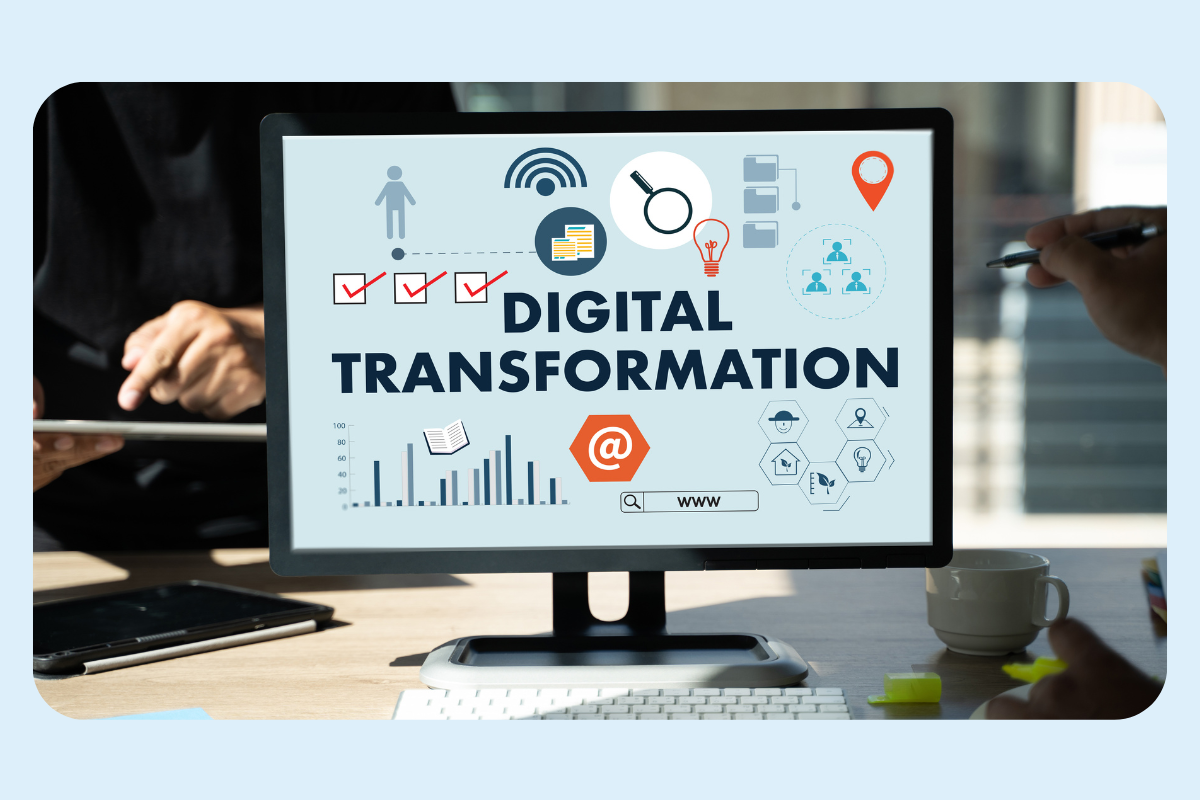
Global Spending on Digital Transformation
By 2026, it’s anticipated that worldwide expenditures on digital transformation technologies and services will soar to $3.4 trillion USD. This significant surge underscores the critical role digital transformation plays in companies’ business models.
Digital Competitiveness Rankings
Denmark’s Leading Position: Denmark is recognized as the most digitally competitive country, thanks to its early and effective adoption of digital technologies. This foresight sets a strong foundation for future growth and innovation.
Embracing Cloud Capabilities: Globally, extending existing solutions through cloud technology is a preferred strategy for digital transformation. This approach significantly enhances business agility and scalability.
Workplace Transformation
The market for workplace transformation is on a substantial upward trajectory. From its already considerable value in 2022, expectations are set for continued growth through 2030 as companies reinvent workspaces and integrate digital tools to boost productivity and employee satisfaction.
AI Investment
Back in 2018, 40% of businesses dedicated over 5% of their digital budgets to artificial intelligence (AI). By 2022, this trend saw over half of businesses maintaining similar investment levels, with 63% planning to increase their AI funding in the subsequent three years.
Economic Impact
By 2023, digitally transformed entities are expected to contribute more than half of the global GDP, representing a massive $53.3 trillion. Around 65% of the world’s GDP is forecasted to be digitized by the same year.
Digital skills and job market
Digital skills are becoming more vital, with 6-12% of all job vacancies in various countries demanding these competencies. As the digital transformation continues, the need for experts in AI, data analytics, and cybersecurity is set to increase.
Predictions for 2024
The rise of augmented intelligence: IDC’s 2024 predictions for digital business focus on the impact of augmented intelligence (GenAI). These insights span various sectors, emphasizing personalized experiences, automation, and data-driven decision-making.
Source: Gartner.
[Read also: 5 Most Popular Healthcare Software Solutions]
What’s the future of digital transformation? 7 important digital transformation trends in 2024
Conducting a successful digital transformation journey isn’t as simple as devoting large sums of money toward cutting-edge tech.
Each strategic decision has to be carefully thought through, as striking the right balance between innovation and growth is a true juggling act and a serious challenge.
1. High-performance software
We are currently living during a digital age, as thousands of terabytes of data are being generated and exchanged across the world. Many companies even state that data is currently their most valuable asset.
It shouldn’t come as a surprise that data management has become a key part of a company’s day-to-day operations, and subpar data analytics tools can hinder digital transformation efforts in a serious way.
After all, customer data is the main source of information and businesses will put the most strategic emphasis on it in the future.
That’s why focusing on data throughput and high-performance software is good advice for almost all companies, regardless of the field they operate in. This is especially true in organizations specializing in financial services and e-commerce.
What do they have in common?
Both of them deal with large amounts of vital information in real-time. That’s why when developing a digital strategy for such companies, low latency software solutions should be at the top of the priorities list.
That’s also why Stratoflow developers hold software performance as one of the key values in our work philosophy. It enabled them to design and deploy cloud software architecture querying billions of financial transactions in sub-second times.
Such an immense amount of information lets the company scale out its operations, substantially improving the overall customer experience in the process.
[Follow-up reading: Are Java Developers in Demand?]

2. No-code/low-code
Software development is an incredibly time-consuming and costly process – everyone who has worked in the IT field can confirm that.
Is there an alternative for making it cheaper and more accessible?
There might be, and it’s called low-code and no-code development.
Low-code and no-code platforms are software development methodologies that enable users with little-to-no coding knowledge to build apps using intuitive UI elements instead of manually typing code. Thanks to this solution, an application development process is less expensive and time-consuming.
However, low-code and no-code platforms put some limits when it comes to the development of more advanced features.
Stratoflow CTO, Arkadiusz Drysch, probably put it best when he said that claims that low-code methodologies will render traditional programming obsolete are greatly exaggerated since there are many various nuances in coding.
Nevertheless, these platforms still offer a unique opportunity to enhance the speed of the development process and increase the pace of becoming a digital organization.
[Follow-up reading: How to Build an App Without Coding: 5 Must-Know Tips]
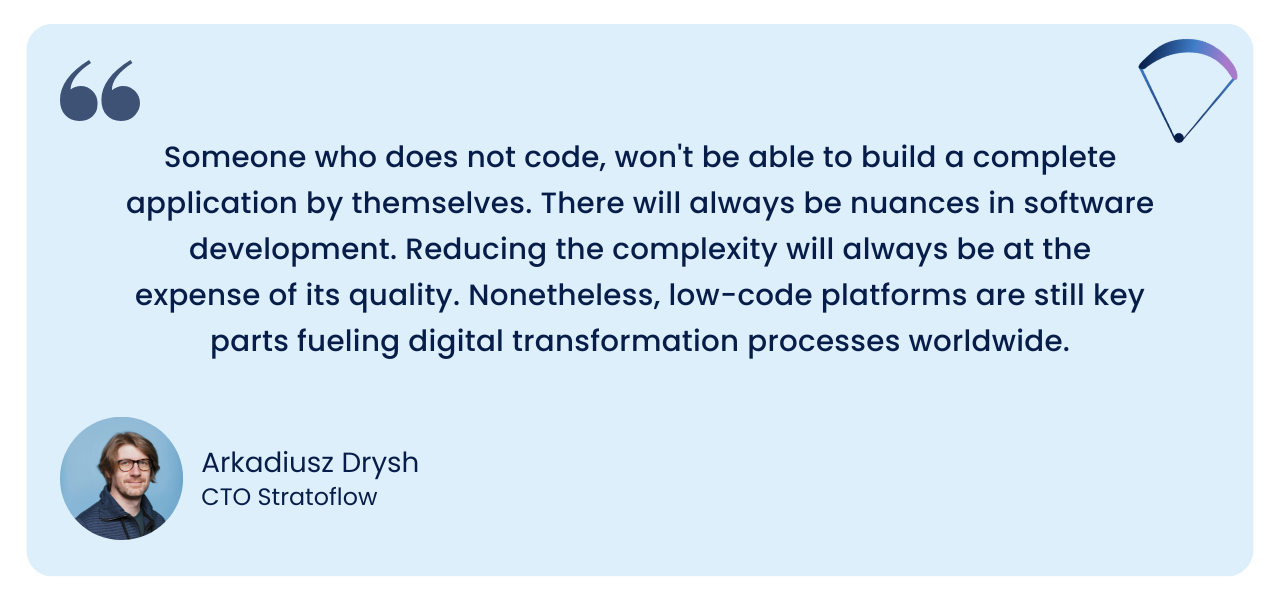
No-code Artificial Intelligence (No-code AI)
One subtype of no-code methodology which is worth mentioning when discussing trends shaping the future of digital transformation is no-code AI.
Usually, integrating AI requires advanced programming knowledge. No-code artificial intelligence platforms, such as Sway AI or Akkio, allow non-AI experts to quickly implement and test their ideas without the need for an advanced set of skills. No-code AI solutions also provide collaboration opportunities between AI and domain experts.
3. Artificial Intelligence (AI) and Machine Learning (ML)
While we are on the topic of no-code AI solutions, let’s take a look at artificial intelligence technology itself, since it is predicted to play a key role in the ongoing digitalization processes.
Even though advanced, self-aware AI is still present only in sci-fi movies, currently many companies across various fields of business are using AI solutions even if it’s not so obvious at first glance.
Let’s take for example e-commerce recommendation engines. These relatively simple software tools that present shoppers with lists of products that they might like are run entirely by AI-enabled algorithms.
And their effects on sales figures are really impressive!
It is estimated that e-commerce stores can observe an actual increase in conversion rates of 5-10% after the implementation of personalized recommendations.
The desire to increase effectiveness drives businesses to automate tasks and improve productivity. According to research conducted last year, up to 76% of organizations have prioritized AI and ML above other IT solutions in their strategies.
There are many enhanced AI solutions such as artificial intelligence of things (AIoT), conversational AI, and AI cloud applications that improve the future of digital transformation and enable business process automation.
Here is a quick comparison of each of these categories:
Artificial Intelligence of Things (AIoT)
AIoT, to put it simply, is an advanced hybrid of AI and the Internet of Things. These two technologies, working in tandem, offer unique capabilities.
AIoT involves intelligent and real-time management capabilities of physical and digital operations across manufacturing execution systems (MES), process control systems (PCS), and enterprise resource planning solutions (ERP).
The emergence of AIoT underscores the need for companies to collaborate with software development partners to view the once separate solutions as a single unit enabling more advanced digital processes.

Conversational AI
Conversational AI is a type of artificial intelligence that enables online users to interact with applications just like with other humans – using their speech.
Chatbots, based on artificial intelligence technology, can improve user experience thanks to leveraging omnichannel sales methodology, maximizing cross-selling opportunities in the process.
According to Markets and Markets research, conversational AI’s global market is expected to grow to $15.7 billion in the next three years. The chatbot market is also likely to see exponential growth, with Research and Markets projecting it to reach $5.63 billion by 2023.
AI on the cloud
The next frontier in the field of digital transformation is combining cloud services with AI-enabled solutions to organize and retrieve data more effectively.
And we are beginning to see examples of such tech successfully deployed in practice.
Smart assistants such as Alexa, Siri, and Google Home have already proven their viability by improving user experience as well as acting as an additional sales funnel for e-commerce companies.
With the adoption of hybrid AI cloud systems, businesses can capitalize on pre-trained learning models to improve their data analytics.
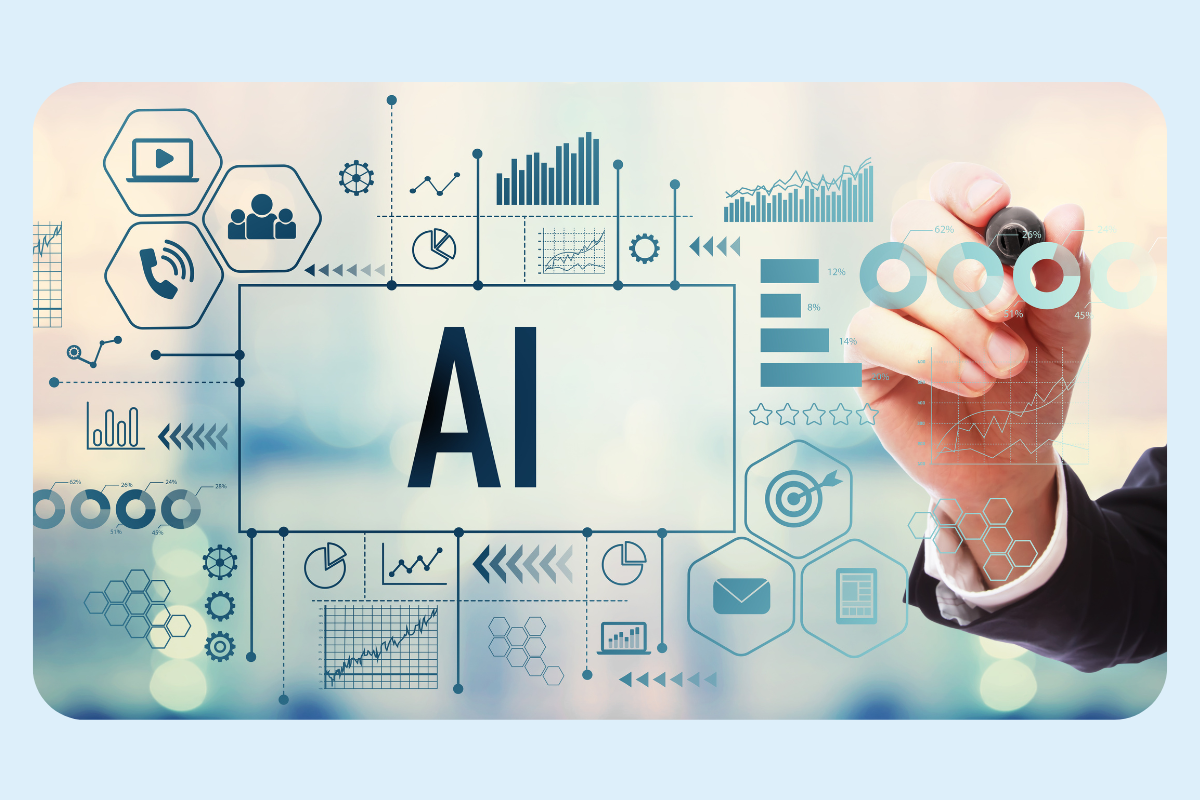
4. Multi-cloud solutions
Imagine that the cloud vendor that you are basing your whole corporate architecture upon decided to raise prices by 50% overnight. You hastily look for other alternatives, but moving the entire enterprise software system to another vendor generates cost by itself and is a huge burden for your entire IT team.
Is there a way to avoid such problems?
Enter multi-cloud solutions.
Multicloud is the approach of using cloud services from multiple vendors. It can be boiled down to using software-as-a-service (SaaS) from two different companies like Salesforce and Workday.
In large companies though, multi-cloud methodology refers to running enterprise-grade applications on infrastructure-as-a-service (IaaS) or platform-as-a-service (PaaS) solutions from multiple cloud service providers, such as Amazon Web Services (AWS), Google Cloud Platform, and Microsoft Azure.
There are a couple of important advantages that a multi-cloud environment offers. Each of these benefits can prove to be vital in performing a successful digital transformation process that isn’t halted mid-way through by some external factors.
Some main advantages of the multi-cloud approach include:
Mitigating vendor lock-in
Vendor lock-in refers to a situation where the cost of switching to a different vendor is so high that the customer is virtually stuck with the original company.
Such a situation greatly limits research and execution perspectives and gives other players on the market an unfair advantage.
By carefully evaluating the business requirements and expectations, and having a strong negotiating position, companies can harness the power of the cloud and receive the best bang-for-the-buck in terms of digital capabilities.
Suitability
When incorporating multiple cloud solutions into a company’s digital strategy, IT leaders are able to line up business requirements with the best cloud-hosting providers for each functionality.
Competitive pricing
Organizations leveraging a multi-cloud approach can enjoy the freedom of comparing different providers and securing the best available deals based solely on digital transformation’s goals.
Flexibility and scalability
Multi-cloud technology allows organizations to scale their digital operations based on an ongoing demand. Companies strive to build a multi-cloud architecture where each solution works seamlessly together, so organizations can dedicate additional resources to specific data segments in order to achieve higher overall throughput.

5. Cybersecurity
All digital transformation initiatives can be futile if the company carrying them out doesn’t pay attention to cybersecurity.
Increased complexity of modern IT infrastructure, distributed cloud systems, and the rise of ransomware, have made cybersecurity one of the main fields of concern among CTOs.
This cybersecurity expert must determine where the organization is at risk at every digital touchpoint. This is usually done by identifying how new applications will be connected to an existing software architecture.
Modern monitoring solutions, like converged security information and event management (SIEM) and user and entity behavior analytics (UEBA), can be implemented at these endpoints. The aim is to ensure a smooth software rollout process as well as compliance with all standards of cybersecurity practices.
[Read also: Legacy Software Systems: How to Live with Aging Software Architecture?]

6. Blockchain development
Blockchain technology in the past has been most closely associated with cryptocurrencies.
However, blockchain has many aces up its sleeve.
The most basic promise of this technology is enhancing security through its immutable records. That’s because blockchains store data using sophisticated math and innovative software solutions that are exceedingly difficult for hackers to manipulate.
This way, the blockchain greatly improves the overall level of trust in peer-to-peer transactions without the need for a middleman to back it up.
As B2B and B2C businesses increasingly shift their operations to the digital sphere, blockchain has the potential to become a pivotal technology for digital transformation processes worldwide.
Last year, there was an explosion in the popularity of non-fungible tokens (NFTs) – unique digital collectibles built on top of cryptocurrencies that can be bought and sold like any other asset class.
Regardless of people’s opinion on NFT’s gold rush that took place a couple of months ago, these digital assets can prove themselves really helpful in a wide variety of businesses, starting from digital art and games to travel and financial markets.
7. Software 2.0
What is one of the most tiresome tasks of a software developer? Creating readable and comprehensive project documentation.
As it turns out, there’s help on the horizon in the form of Software 2.0.
It is really quite an intriguing concept. The main idea behind it is to create source code automatically straight from a requirements document.
As of today, Software 2.0 still exists only in the concept phase. One of the main challenges of this approach is the need for high data quality and next-level data analytics.
However, even considering the current limitations, the implications of Software 2.0 are fascinating. It has the potential to transform how digitalization is approached in smaller organizations that can’t afford robust IT departments.
As the digital transformation goals of many organizations grow in scope, companies are looking for cheaper and faster ways of writing code. Software 2.0 might turn out to be a perfect way to boost digital initiatives to a whole new level.
[Read also: The Most Common Problems in Software Development]
How to lead a successful transformation project
The digital transformation journey is like an intricate machine in which every single part and every single gear has to work as intended.
How do you ensure there won’t be any hiccups along the way?
Here are five key aspects of a successful transformation project:
Clear product vision
Before engaging in any technical work and integration business processes, a clear vision of the company’s digital future has to be established.
Great level of Connectivity
These companies are able to easily connect people, processes, and data through a flexible platform that supports the speed of innovation.
Superb Customer Experience
In today’s highly competitive online markets, customer experience plays a key role in building a stable and loyal customer base.
Businesses undergoing a digital transformation process have to identify key touchpoints that are most important to their customers and focus on perfecting UI and software performance.
Speed and website performance
The less time online operations take, the more user-friendly they are.
These should not come as a surprise to anyone. Today we are simply used to looking for information online, using banking technology or entertainment applications that don’t make us wait for them.
With the right tools, you can measure the performance of your website, check which elements are slowing it down, and work on them improving the overall latency.
Digital Innovation
These days, at the heart of every successful business, there should be a strong culture of innovation.
Constantly searching for innovative solutions and ways of integrating them into the company’s daily operations is a key to gaining a strong edge over the competition.
An expert’s point of view: how digital transformation is changing the world?
What can you do to ensure that digital transformation in your organization is going as smoothly as possible and that available resources are being used properly?
We asked Arkadiusz Drysch, Stratoflow CTO, to share some insights on what factors are determining the success of digital transformation efforts:
“In the face of rising costs and the complexity of technologies and businesses, a key factor in digital transformation projects is the ability to choose the right combination of tools from among the hundreds available”.
The company’s resources are limited.
When digitally transforming, it is crucial to pick these aspects that influence the conversion rates and customer base the most. These fields should be given priority at least in the initial phases of the whole transformation process.
Companies can also search for ways of simplifying the entire ordeal by using tools like low-code and no-code development and fast coding platforms from SaaS companies.
“Certainly, companies can significantly reduce implementation time and increase ROI by using Low-Code / No-Code tools. Nevertheless, it is necessary to identify the limitations of these tools and plan in advance which processes will need to be implemented through integration and which have to be integrated manually. Flexibility and integration possibilities are the ultimate limiting factors of any modern software tool” — Arkadiusz Drysch added.

Future of digital transformation and digital technology – final thoughts
One thing is for sure – digital transformation is here to stay.
Embrace it and your company will be rewarded with boosted revenue growth, higher customer loyalty, and a strategic advantage over the competition.
These days, lagging behind in terms of modern digital tech is like purposely giving your foes a chance to gain an advantage over you in the field that matters the most – customer experience.
So don’t wait and start transforming your organization today!
Related Posts
- Best AI for Coding: Top 10 AI Tools for Software Developers in 2025
- How to Build a Document Management System: Alternative Approach
- How to Prepare a Successful Application Migration Project
- Software Development Process: Complete 2025 Guide
- Complete Guide To Replatforming – Definition and Best Practices
We are Stratoflow, a custom software development company. We firmly believe that software craftsmanship, collaboration and effective communication is key in delivering complex software projects. This allows us to build advanced high-performance Java applications capable of processing vast amounts of data in a short time. We also provide our clients with an option to outsource and hire Java developers to extend their teams with experienced professionals. As a result, the solutions designed for our customers contribute to their business development. We specialize in travel software, ecommerce software, and fintech software development. In addition, we are taking low-code to a new level with our Open-Source Low-Code Platform.
